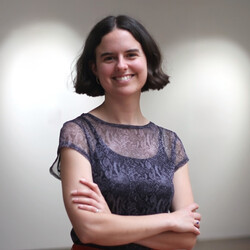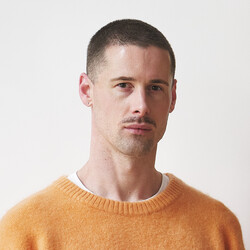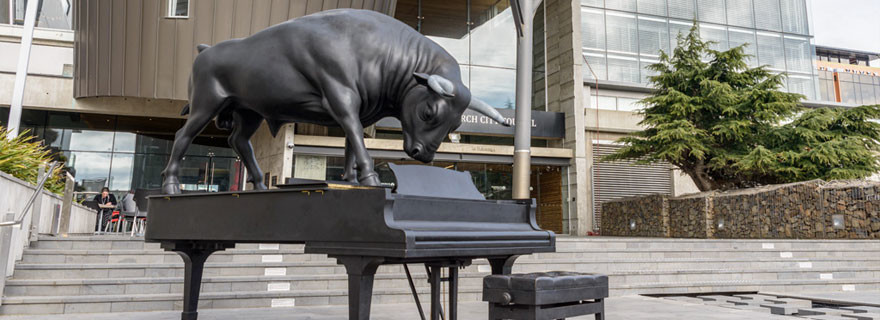
Bringing threads together
Dr Lara Strongman is the Gallery's new senior curator. She speaks to Bulletin about her passion for writing and art history, the importance of culture in a post-earthquake community and the contemporary curator.
On writing about art
'I owe much of my interest in art and art writing to my mother, Thelma Leggat. She had an extensive library of second-hand art books, and one of my earliest memories was sitting on her knee and looking at them with her – a lovely, formative childhood experience. I grew up surrounded and influenced by art. My parents knew artists from whom they would occasionally buy pieces – not high-value works, but works that were certainly valued by our family. My parents didn't grow up with art in their own homes, but it was something they came to as adults. I grew up in England and we used to visit historic houses, museums and art galleries at the weekends and on holidays; it was what we did together as a family. We lived in Exeter – a cathedral and university town in the south-west, a bit like Christchurch – and my favourite place to visit was the Royal Albert Memorial Museum and Art Gallery. At the University of Exeter, where my father taught, there was a major Barbara Hepworth sculpture that my brother and I used to be fascinated by, poking our heads through the holes like the characters in the short story 'Neck' by Roald Dahl. My childhood experience was that art could hang in a museum, but it also somehow belonged to you, and you could go and see it whenever you liked. Art could be public and yet hold private meaning and significance. I understood early on that artists have a special way of seeing the world that repays close attention.
'When we moved to New Zealand, as a teenager I was interested in theatre, film and music – wider cultural pursuits, I suppose. But gradually, contemporary art came into focus as the thing that most intrigued me. I was fascinated by the power of works of art – the emotional and psychological power, the kind of resonance that art has in culture. That was something I didn't understand but I wanted to. Writing about art is a process of research and understanding. Each work you write about teaches you something new.'
On art history
'Art history, in particular, is so appealing to me because it draws on such a wide range of other disciplines – history, geography, sociology, political theory, cultural studies, ethics and more. At its heart it is the history of representation, which is quite a socially and politically charged term. Historical art can be a time machine for us – a single point of focus that opens up something of the lives and experiences of the people who came before us. I think art is a wonderful tool for understanding tradition and culture and, through the eyes of our best artists, it can create possibilities for the future. It gives us ideas about things that we haven't thought of yet, possibilities that no one else has yet imagined. It's a different way of seeing how we are today and how we might be in the future, and that's a very interesting proposition. A work of art, if you care to engage with it, will let you go back and forth through time and possibility.'
On art post-quakes
'I think art has a very significant role to play in Christchurch as it gradually regathers and, in many ways, reinvents itself. The experience of being here through each earthquake and aftershock made it clearly evident that art and culture are not optional extras, not merely nice-to-haves once everything else is sorted. People started interpreting their experiences of the February 2011 earthquake from the very next day. They started writing songs about it, making dances, images, and interventions in public spaces that you might well count as forms of sculpture – all of that interpretation and personal expression started happening straight away. The other thing people did almost immediately was start to beautify their environments. Despite the ruin and the rubble, they started gardening, making little spaces and new public places to be sociable in, to be a community in again. And art played a very strong role in that. It was fascinating to observe. Art wasn't waiting for the city to be fixed or 'normal' again, it was happening right in the middle of a disaster. People desperately wanted to be engaged and involved, and they were making art – sharing it via word of mouth and social media. As we now move through this transitional phase of gradual rebuilding, I think the Gallery continues to play a crucial role in catering for that involvement. It offers both space for contemplation and stimulus to the imagination. But importantly, it also provides access to tradition, to the historical artworks that people in the city have known and loved forever. They're still there, being looked after, waiting for the Gallery's doors to swing open again. And I think that's going to be a very significant and emotional moment for people. I know it will be for me.
'Resilience is a word we've heard often in relation to local culture over the three-and-a-half years since the earthquakes. It strikes me that art itself is actually a very resilient pursuit. Art brings together and makes new combinations out of things that have sometimes been discarded. It compels you to see things in new ways, creates new possibilities and experiments with culture. It bounces forward rather than back. And I think that resilient societies need artists because artists signal shifts in culture. A resilient society is a mobile society – one that needs to keep moving and responding in creative ways to new challenges, which is essentially what artists do everyday. Beyond that, resilient communities need innovation. People need to innovate in order to adapt to constantly changing circumstances. And one of the fundamental conditions of innovation – what lies behind it – is creativity. Innovation is applied creativity, if you like, or creativity applied to a particular circumstance. Art, however, doesn't apply creativity to anything apart from itself. I'd argue that art is the fundamental cornerstone of resilience and innovation; it's the creative energy that we need at the basis of our community in order to move forward.
'This is a fascinating time for art and culture in Christchurch. The experiences of the last few years have been extraordinarily difficult for many people, but they've also been – if I can speak dispassionately for a moment – an incredibly interesting time to observe the workings of culture in our community. My sense is that local people have a stronger and more defined personal relationship with art and cultural expression, and this is manifest in the plethora of public art and public-space interventions we've seen, from Gap Filler, Greening the Rubble, the Rise street-art festival and the Gallery's Outer Spaces programme among others – including dozens of public works of art by anonymous authors. The energy in these endeavours and the wide interest in them suggests that Christchurch people have an even closer relationship with culture since the earthquakes, and I think the Gallery has played a commendable part in making our city feel 'normal' again – as a home for culture and artistic expression within the city. The Gallery has an important role to play in taking us forward and in being a resource for the community's imagination, which I'd regard as even sharper and more distinct since the earthquakes.'
On curating
'Before I contemplated becoming a curator, I thought for some time that I might train to be an actor. I worked with the Free Theatre in Christchurch for a number of years in my late teens and early twenties, which I thoroughly enjoyed. But I also enjoyed spending time with artists and I had a particular fascination with contemporary art. When an assistant curator role came up at the Robert McDougall Art Gallery, as I was finishing my master's degree, I leapt at the opportunity. I was appointed to run the contemporary art programme at the Art Annex, so I didn't often work with the collection – I worked with artists and the community, both locally and nationally. What I didn't realise at the time was that I had joined on the cusp of quite a significant shift in the role of the curator; the traditional role of keeper of the collection was expanding into a broader relationship with the art world. Another change that was on the way was the blurring of boundaries we now commonly refer to as globalisation, which today is very much evidenced in the way artists work. Today New Zealand artists may live in New Zealand, or they may not. They have exhibition practices back home as well as internationally. Artists are increasingly mobile and I think the idea of being a New Zealand art curator is changing because the definition of New Zealand art is changing. But public gallery curators work in one place and they work for, and within, their local community. So it's an interesting cultural shift and the challenge is around connecting the local to the international in a meaningful way.
'Today, I think that to curate is to network. A curator is one single point in a complex network encompassing artists, artworks, ideas, audience and community. An important aspect of my new role is to bring cultural threads together; to engage ideas and people, to link different times and places, to strike the spark which in turn ignites conversations. The hope is always that those conversations resonate beyond the walls of the Gallery. Fundamentally, I'm a joiner, a door-opener, a conduit of ideas that are worth sharing, to borrow the TED phrase. Contemporary curators encounter those ideas in artists' studios and then, back at the gallery, they advocate for those ideas and their wider importance. You seek to champion artists' ideas and to bring them to wider public attention through the mechanisms of a gallery. Being a champion, however, isn't entirely distinct from also being a cultural agitator. Part of the curator's role is working with artists to define problems in the culture – not to solve or create solutions to those problems, but to reframe ways of viewing our situation. Artists give us new ways of looking at the everyday world.'
On 'good' art
'There's a kind of mystery that lies at the heart of certain works of art, an elusiveness and inability to be entirely pinned down. That's what I particularly value in an artwork, and I think it's what allows them to resonate with people in different times and places. The sort of works I'm talking about are open texts, generously produced, and they allow room for the viewer to engage with them and be stirred by them. When two people look at a work of art it can be an entirely different experience for each person; they inevitably draw from their personal perceptions and bring those to their experience of the artwork. I think good works of art afford that; they allow and enable different forms of engagement. There's something you recognise in them about yourself. Equally though, there's also something you don't understand at all, an element that evades definition. I think one of the strongest examples we've seen in this post-quake period was Michael Parekowhai's On First Looking Into Chapman's Homer – "The Bull". So many different people engaged with it at so many different emotional levels, even if they knew nothing about the artwork. But there's a nagging elusiveness about the work, where you're not really sure what it's about or what it means for it to be there; there's something that sticks in your mind and leaves you continually wondering, 'what is it?', 'what does it mean?', 'what is it doing?' That quality in a work of art, which compels imaginative projection by the viewer but equally resists capture, is what I look for.'
Lara Strongman was interviewed by James Richardson in July 2014.






